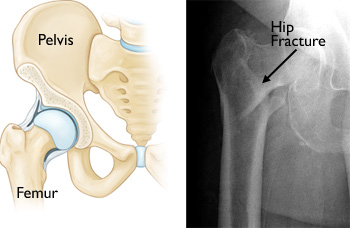
Hip Fracture Prevention
Hip fractures are breaks in the thighbone (femur) just below the hip joint. They are serious injuries that most often occur in people aged 65 and older.
Women are especially vulnerable to hip fractures. According to 2010 data from the National Hospital Discharge Survey, approximately 70% of hip fractures occur in women.
Hip fractures can limit mobility and independence. Most hip fractures require surgery, hospitalization, and extended rehabilitation.
Most people who previously lived independently before hip fracture require assistance afterward. This can range from help from family members and home health professionals, to admittance to a nursing home or other long-term health facility.
 Hip fractures occur in the upper section of the femur (thighbone). The x-ray image on the right shows a hip fracture.
Cause
Hip fractures occur in the upper section of the femur (thighbone). The x-ray image on the right shows a hip fracture.
Cause
Most hip fractures are caused by factors that weaken bone, combined with the impact from a fall.
Bone Strength
Bone strength decreases as we age. Bones can become very weak and fragile — a condition called osteoporosis. Osteoporosis often develops in women after menopause, and in men in older age. This bone-thinning disorder puts people at greater risk for broken bones, particularly fractures of the hip, wrist, and spine.
Risk Factors
Many of the factors that put you at greater risk for a hip fracture are those that cause bone loss.
- Age. The risk for hip fractures increases as we age. In 2010, more than 80% of the people hospitalized for hip fractures were age 65 and older, according to the National Hospital Discharge Survey (NHDS).
- Gender. In 2010, 72% of hip fractures in people aged 65 and older occurred in women (NHDS).
- Heredity. A family history of osteoporosis or broken bones in later life puts you at greater risk for a hip fracture. People with small, thin builds are also at risk.
- Nutrition. Low body weight and poor nutrition, including a diet low in calcium and Vitamin D, can make you more prone to bone loss and hip fracture.
- Lifestyle. Smoking, excessive alcohol use, and lack of exercise can weaken bones.
In addition to factors that affect bone strength, things that put you at greater risk for falling can increase the possibility of hip fracture.
- Physical and mental impairments. Physical frailty, arthritis, unsteady balance, poor eyesight, senility, dementia and/or Alzheimer's disease can increase the likelihood of falling.
- Medications. Many medicines can affect balance and strength. Side effects of some medications can also include drowsiness and dizziness.
Home Safety
Most hip fractures occur as a result of a fall, and most falls occur in the home. Many falls can be prevented by simple home safety improvements, such as removing clutter, providing enough lighting, and installing grab bars in bathrooms.
For more comprehensive information on preventing falls: Guidelines for Preventing Falls
Exercise
Moderate exercise can slow bone loss and maintain muscle strength. It can also improve balance and coordination. Good exercise options include climbing stairs, jogging, hiking, swimming, dancing, and weight training.
Balance training and tai chi have been shown to decrease falls and reduce the risk of hip fracture. Tai chi is a program of exercises, breathing, and movements based on ancient Chinese practices. These classes can also increase self-confidence and improve body balance.
Be sure to talk to your doctor if you are just beginning an exercise program.
Understand Your Health and Medications
Each year, be sure to have an eye examination, as well as a physical that includes an evaluation for cardiac and blood pressure problems. Talk with your doctor about the side effects of any medications and over-the-counter drugs you take. It is helpful to keep an up-to-date list of all medications you take so that you can provide it to any other doctors with whom you consult.
Maintain Your Bone Health As You Age
This public service announcement from the American Academy of Orthopaedic Surgeons reviews some major ways to keep bones healthy and prevent osteoporosis.
As we age, our bones are affected by genetics, nutrition, exercise, and hormonal loss. We cannot change our genes, but we can control our nutrition and activity level, and if necessary, take osteoporosis medications.
There are things you can do to maintain and even improve your bone strength.
- Understand your individual risk for fracture. This is based on any risk factors you have for fracture and your bone density. Ask your doctor if you need a bone density test.
- Understand your individual risk for bone loss. Genetics plays a role in bone health, and some people have genetically determined high rates of bone turnover after menopause or with aging. Talk to your doctor about bone metabolism testing. Bone metabolism testing can provide additional information about your risk for fracture.
- Make healthy lifestyle choices. Maintain a healthy weight and eat a diet rich in calcium and Vitamin D. Do not smoke and limit your alcohol intake.
- Consider bone-boosting medications. In addition to calcium and Vitamin D supplements, there are many drug options that slow bone loss and increase bone strength. Talk to your doctor about these methods for protecting your bones.
Learn more about bone health and osteoporosis prevention: Bone Health Basics
Source: National Hospital Discharge Survey, National Center for Health Statistics. As reported by the Centers for Disease Control and Prevention, http://www.cdc.gov/homeandrecreationalsafety/falls/adulthipfx.html. Accessed December 2012.
Source: http://orthoinfo.aaos.org/topic.cfm?topic=A00309
